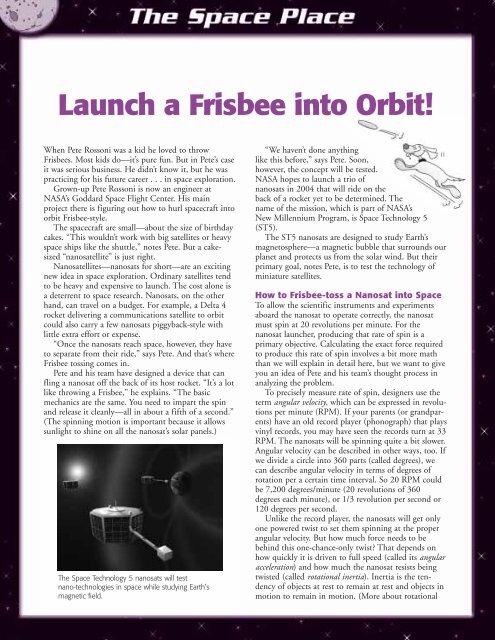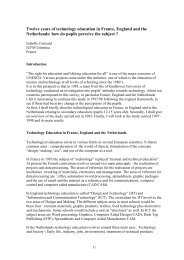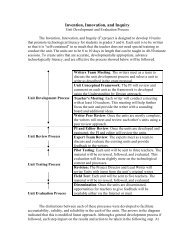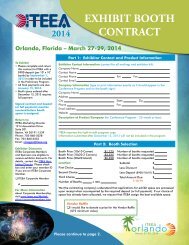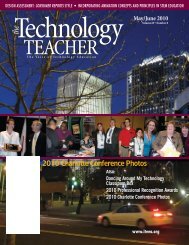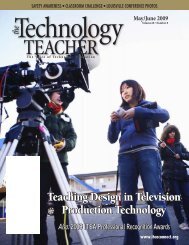april 2003 vol. 62 no. 7 - International Technology and Engineering ...
april 2003 vol. 62 no. 7 - International Technology and Engineering ...
april 2003 vol. 62 no. 7 - International Technology and Engineering ...
Create successful ePaper yourself
Turn your PDF publications into a flip-book with our unique Google optimized e-Paper software.
Launch a Frisbee into Orbit!<br />
When Pete Rossoni was a kid he loved to throw<br />
Frisbees. Most kids do—it’s pure fun. But in Pete’s case<br />
it was serious business. He didn’t k<strong>no</strong>w it, but he was<br />
practicing for his future career . . . in space exploration.<br />
Grown-up Pete Rossoni is <strong>no</strong>w an engineer at<br />
NASA’s Goddard Space Flight Center. His main<br />
project there is figuring out how to hurl spacecraft into<br />
orbit Frisbee-style.<br />
The spacecraft are small—about the size of birthday<br />
cakes. “This wouldn’t work with big satellites or heavy<br />
space ships like the shuttle,” <strong>no</strong>tes Pete. But a cakesized<br />
“na<strong>no</strong>satellite” is just right.<br />
Na<strong>no</strong>satellites—na<strong>no</strong>sats for short—are an exciting<br />
new idea in space exploration. Ordinary satellites tend<br />
to be heavy <strong>and</strong> expensive to launch. The cost alone is<br />
a deterrent to space research. Na<strong>no</strong>sats, on the other<br />
h<strong>and</strong>, can travel on a budget. For example, a Delta 4<br />
rocket delivering a communications satellite to orbit<br />
could also carry a few na<strong>no</strong>sats piggyback-style with<br />
little extra effort or expense.<br />
“Once the na<strong>no</strong>sats reach space, however, they have<br />
to separate from their ride,” says Pete. And that’s where<br />
Frisbee tossing comes in.<br />
Pete <strong>and</strong> his team have designed a device that can<br />
fling a na<strong>no</strong>sat off the back of its host rocket. “It’s a lot<br />
like throwing a Frisbee,” he explains. “The basic<br />
mechanics are the same. You need to impart the spin<br />
<strong>and</strong> release it cleanly—all in about a fifth of a second.”<br />
(The spinning motion is important because it allows<br />
sunlight to shine on all the na<strong>no</strong>sat’s solar panels.)<br />
The Space Tech<strong>no</strong>logy 5 na<strong>no</strong>sats will test<br />
na<strong>no</strong>-tech<strong>no</strong>logies in space while studying Earth’s<br />
magnetic field.<br />
“We haven’t done anything<br />
like this before,” says Pete. Soon,<br />
however, the concept will be tested.<br />
NASA hopes to launch a trio of<br />
na<strong>no</strong>sats in 2004 that will ride on the<br />
back of a rocket yet to be determined. The<br />
name of the mission, which is part of NASA’s<br />
New Millennium Program, is Space Tech<strong>no</strong>logy 5<br />
(ST5).<br />
The ST5 na<strong>no</strong>sats are designed to study Earth’s<br />
magnetosphere—a magnetic bubble that surrounds our<br />
planet <strong>and</strong> protects us from the solar wind. But their<br />
primary goal, <strong>no</strong>tes Pete, is to test the tech<strong>no</strong>logy of<br />
miniature satellites.<br />
How to Frisbee-toss a Na<strong>no</strong>sat into Space<br />
To allow the scientific instruments <strong>and</strong> experiments<br />
aboard the na<strong>no</strong>sat to operate correctly, the na<strong>no</strong>sat<br />
must spin at 20 re<strong>vol</strong>utions per minute. For the<br />
na<strong>no</strong>sat launcher, producing that rate of spin is a<br />
primary objective. Calculating the exact force required<br />
to produce this rate of spin in<strong>vol</strong>ves a bit more math<br />
than we will explain in detail here, but we want to give<br />
you an idea of Pete <strong>and</strong> his team’s thought process in<br />
analyzing the problem.<br />
To precisely measure rate of spin, designers use the<br />
term angular velocity, which can be expressed in re<strong>vol</strong>utions<br />
per minute (RPM). If your parents (or gr<strong>and</strong>parents)<br />
have an old record player (pho<strong>no</strong>graph) that plays<br />
vinyl records, you may have seen the records turn at 33<br />
RPM. The na<strong>no</strong>sats will be spinning quite a bit slower.<br />
Angular velocity can be described in other ways, too. If<br />
we divide a circle into 360 parts (called degrees), we<br />
can describe angular velocity in terms of degrees of<br />
rotation per a certain time interval. So 20 RPM could<br />
be 7,200 degrees/minute (20 re<strong>vol</strong>utions of 360<br />
degrees each minute), or 1/3 re<strong>vol</strong>ution per second or<br />
120 degrees per second.<br />
Unlike the record player, the na<strong>no</strong>sats will get only<br />
one powered twist to set them spinning at the proper<br />
angular velocity. But how much force needs to be<br />
behind this one-chance-only twist? That depends on<br />
how quickly it is driven to full speed (called its angular<br />
acceleration) <strong>and</strong> how much the na<strong>no</strong>sat resists being<br />
twisted (called rotational inertia). Inertia is the tendency<br />
of objects at rest to remain at rest <strong>and</strong> objects in<br />
motion to remain in motion. (More about rotational


